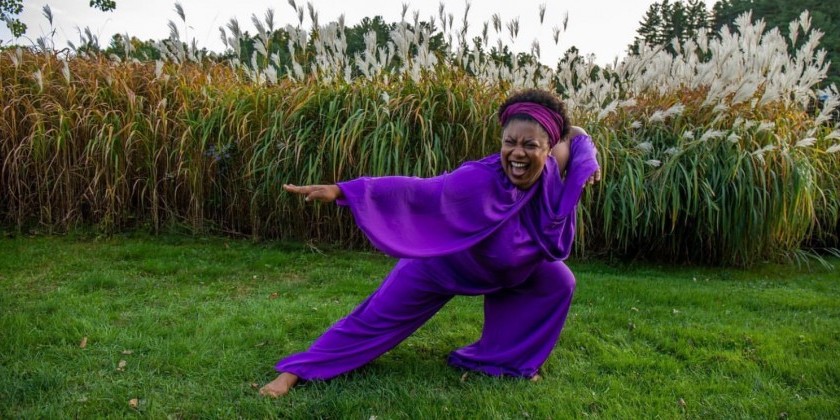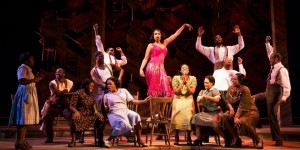THE DANCE ENTHUSIAST ASKS: Sydnie L. Mosley Dances Presents "PURPLE: A Ritual in Nine Spells"

An Evening-Length Choreopoem Embodying the Power of Deep Sisterhood
WHAT: PURPLE: A Ritual in Nine Spells (World Premiere), an evening-length choreopoem embodying the power of deep sisterhood for social change through storytelling and movement.
WHO: Sydnie L. Mosley Dances | Co-presented by Gibney and Lincoln Center
WHEN: June 9 - 11, 16 - 18, 23 - 25, 2023 from 7 - 9pm
WHERE: Samuel B. & David Rose Building, 165 West 65th Street, Lincoln Center, Lincoln Center Lobby, and Gibney, 280 Broadway, New York, NY
MORE INFO: CLICK HERE

Catherine Tharin for The Dance Enthusiast: An inspiration for PURPLE: A Ritual in Nine Spells, Alice Walker's The Color Purple sees women protagonists who live violent lives in a racist society. The women support one another and try to keep each other safe. In what ways does PURPLE reflect aspects of The Color Purple?
Sydnie L. Mosley, Choreographer and Founder of Sydnie L. Mosley Dances: PURPLE reflects The Color Purple in a multitude of ways. Published in 1982, I have only ever existed in a world where The Color Purple exists and so the teachings unearthed by Alice Walker in this novel are foundational to how I understand relationships to, with, and for Black women. While SLMDances’ stage work does not explicitly depict structural violence, it absolutely refers to it and demonstrates its impact on the bodies of Black women and nonbinary folks. PURPLE continues to reflect The Color Purple by illuminating the salve for this violence: the intimacy and relationships between these folks.
Another tangible and tactile reflection is in the set and installation design by Shani Peters featuring quilts by Dr. Kim F. Hall, and costume design by Annie J. Le. In the novel, textile arts are tools of transformation and liberation. Quilting is an act of reparation for Celie and Sofia. (“Let’s make quilt pieces out of these messed up curtains, she say. And I run and git my pattern book. I sleeps like a baby now.”) Later on in the novel, Celie self-actualizes as a woman and artist through sewing pants. One of the ways that she and Mr.__ repair their relationship is when he takes an interest in her sewing and begins learning from her and helping her make pants.
The Dance Enthusiast: Another Black woman author who inspired PURPLE is feminist Ntozake Shange, who called her theater work, for colored girls who have considered suicide / when the rainbow is enuf, a choreopoem, one that considers the lives of women who suffered racism, violence, and sexism. In what ways does PURPLE reflect aspects of Ntozake Shange’s oeuvre?
Sydnie L. Mosley: PURPLE operates in the legacy of the choreopoem by enacting Shange’s words from her essay “why i had to dance”: “it is possible to start a phrase with a word and end with a gesture/ that’s how i’ve lived my life/ that’s how i continue to study/ produce black art.” SLMDances understands that by devising dances of words and gestures, thoughts and actions, and gathering to share that with one another, we are creating opportunities for deep reflection on our humanity.
PURPLE takes inspiration and instruction from for colored girls not only in its theatrical form, but in taking the time to follow the character and story of a multitude: in our case, 12 women and nonbinary folks. Our title A Ritual In Nine Spells is a nod to Shange’s 1979 play, Spell #7. The idea of spells and ritual are present not only in this stage work, but also her first novel Sassafrass, Cypress & Indigo. Similar to The Color Purple this novel deeply centers sisterhood and coming of age as Black woman.

The Dance Enthusiast: Walker was born in 1944, Shange in 1948, and you in 1985. You carry forth a legacy of Black women wordsmiths who are social activists. In what ways has this legacy advanced from their lifetimes to yours? What do you envision for the future?
Sydnie L. Mosley: I am producing PURPLE about four decades after some of Shange and Walker’s most pivotal works were published. Through my work, I am carrying on the legacy specifically of Black feminists and feminisms. Their work taught me how critical a radical feminism is. Across both of Walker and Shange’s bodies of work (and many others), the antidote for injustice is Black women caring for themselves. As Shange wrote in for colored girls, “i found god in myself and i loved her/i loved her fiercely.”
This legacy has advanced in my lifetime as we have grown our understanding and articulation of gender; a radical feminism that includes trans and nonbinary folks is how we love each other and ourselves fiercely. Resistance to racial capitalism through shifts in cultural norms around rest and wellness have also advanced in my lifetime; grind culture is out and Tricia Hersey’s Nap Ministry is in!
One of the essential questions PURPLE asks is: What is your vision for a radically joyful future? That question inherently asks us to expect joy (and pleasure and fun and the best of life!) at any and all costs for our tomorrows — especially Black women and gender expansive folks. It asks us to practice imagining for ourselves and self-determine what we desire. It asks us to be attuned enough to our present moment, that we can name our needs for the next moment. My vision for the future is that we are all steeped in these practices as the tools to love ourselves fiercely.
The Dance Enthusiast: Tell us about the idea of sacred ritual in PURPLE, Choreopoem – A Ritual in Nine Spells.
Sydnie L. Mosley: PURPLE asks Witness-Participants to define sacred rituals for themselves. Our performance work and its creative process aggregates a myriad of rituals that are meaningful to the performers in the work and resonate with our research. Some of the rituals that have sustained our creative practice include: rehearsal, dialogue with elders, meditating with lavender, and altar building.

The Dance Enthusiast: You are creating solos for Dyane Harvey and Charmaine Warren, elder dancers of note. Could you describe your approach to choreographing these solos?
Sydnie L. Mosley: Both solos have been woven into our evening length performance and Charmaine’s solo has evolved into a role now performed by Rosamond S. King.
Dyane was grieving Ntozake Shange, her longtime friend and artistic collaborator, and wanted to do something that honored her. It was kismet – in September 2018, I moderated a public conversation with Shange at Barnard College, one of the last public engagements she did before she passed the very next month. Dyane and I were aligned in our desires to weave Shange’s creative legacy through the work. One of my favorite parts of our process was that we exchanged Shange works with each other that we hadn’t read – Dyane gave me Spell #7 and I gave her lost in language & sound.
Charmaine actually attended the first work in progress showing of Dyane’s solo in which we asked audience members to sit on stage, and her enthusiastic participation prompted me to invite her to collaborate. She also had a relationship with Shange, and so that basis was foundational to the beginnings of both solos.
For both creative processes, I led with curiosity. I asked: What brings you joy? What feels like a miracle in your life? What does transition mean for you? When was the last time you felt seen? We would talk a lot in rehearsals, and I would take notes. We improvised a lot. I also taught each of them some phrase material that I call the PURPLE movement theme, and then we played with it – broke it apart, remixed it, added layers of words and music. From there I shaped the material.

The Dance Enthusiast: Research for PURPLE is based in archives and stars, bodies, and stories. Can you describe what made up your research?
Sydnie L. Mosley: In our dramaturgical practice for this work, we have visited the archive collection of Ntozake Shange at Barnard College, the rare dance book collection in the archives at Penn State University, and have an active archiving practice of our own creative work. We pay attention to the stars and the moon, both tracking constellations in wide open skies when we go on a creative residency to places such as Double Edge Theater in western Massachusetts and setting New Moon intentions for our creative and organizational practices. We are in a practice of presence with our bodies in this work and seek attunement with our individual bodies and the bodies we are dancing with. Our own stories, our elders’ stories and community stories inform our work.
The Dance Enthusiast: Quilts provide warmth, and in their creation, bring the sisterhood together. In what ways are quilts an essential element in PURPLE?
Sydnie L. Mosley: Quilts, sewing, and weaving are symbolic in the novels The Color Purple and Sassfrass, Cypress & Indigo, and those themes also show up in our staged work. The forms of both novels weave together letters, prayers, rituals, spells, and more.














